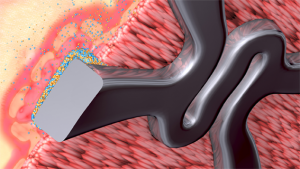
Newer drug-eluting stents that contain a biodegradable polymer have a lower risk for complications than first-generation drug-eluting stents which contain a permanent polymer, reported medical journalist Michael O’Riordan of heartwire on Friday, March 30 (if the link doesn’t work, try copying and pasting “Solid four-year safety and efficacy data with biodegradable-polymer DES” into Google). The conclusion came from a study of data collected from a number of clinical trials that took place over several years.
Stents are artificial tubes that prop open cardiac and other blood vessels. O’Riordan wrote in his article the study consisted of 2,358 patients with a biodegradable-polymer stent, such as the Yukon Choice PC or BioMatrix Flex stents, and 1,704 patients received a CYPHER stent which has a permanent polymer.
These stents release drugs while in the body. In the case of the biodegradable polymer ones, the polymer slowly dissolves into the body over months and disappears when its job is done, such as this example.
O’Riordan quotes Robert Byrne of the German Heart Centre in Munich, who was one of the first co-authors of the study as saying, “With biodegradable polymers, the whole concept behind the technology is quite attractive, in terms of reducing late safety events, such as stent thrombosis, but in the individual studies we didn’t really see a clear result, even with the relatively long-term follow-up.” Byrne added that in order to see the rare lapses in safety, they needed to study really large numbers of patients.
The current study was presented on March 24 at the American College of Cardiology 2012 Scientific Sessions and appeared online at the same time in the European Heart Journal.
O’Riordan explains that at a conference last year, Byrne discussed data that was collected over three years that demonstrated that the biodegradable polymers instigated fewer cases of stent thrombosis and had better clinical outcomes than stents with permanent polymers. The current study presents data over four years, with more patients.
O’Riordan concludes his article with a long quote from Byrne:
‘If you asked me, I think biodegradable-polymer drug-eluting stents look like they’ll play an increasing role as a workhorse stent in many cath labs around the world,’ said Byrne. ‘I suppose whether that happens in the US will depend on the Food and Drug Administration. The other question is whether these stents are just a bridge — are we waiting for the fully bioabsorbable scaffolds to come along? It’s interesting speculation, but the biodegradable-polymer stents seem to be a good product, and whether bioabsorbable scaffolds get into day-to-day use in broad, unselected patients and lesions remains an open question. I’d say probably not in the next five years, but maybe 10 years down the line.’
Source: “Solid four-year safety and efficacy data with biodegradable-polymer DES,” heartwire, 03/30/12
Image by Biosensors International, used under Fair Use: Reporting.
